EDH70204: Teaching Practice and Learning Reflection Assignment
VerifiedAdded on 2022/10/12
|14
|4122
|416
Homework Assignment
AI Summary
This document presents a comprehensive homework assignment from a Master of Teaching and Learning program (EDH70204), focusing on principles of learning and teaching in social studies. The assignment is divided into three parts: inquiring into own practice, transforming classroom practice, and reflecting on classroom practice. Part A involves self-reflection on the teacher's experience, teaching approaches, student learning, and the impact of class size. Part B requires designing a lesson plan, specifying learning objectives, teaching methods, and incorporating soft skills and differentiated instruction. The lesson plan includes activities and addresses potential problems. Part C reflects on changes in understanding of teaching and students before and after the course, and identifies areas for improvement. The assignment covers various aspects of teaching, including curriculum, learning theories, and practical application of teaching methods. The document provides detailed answers and justifications for each section of the assignment.
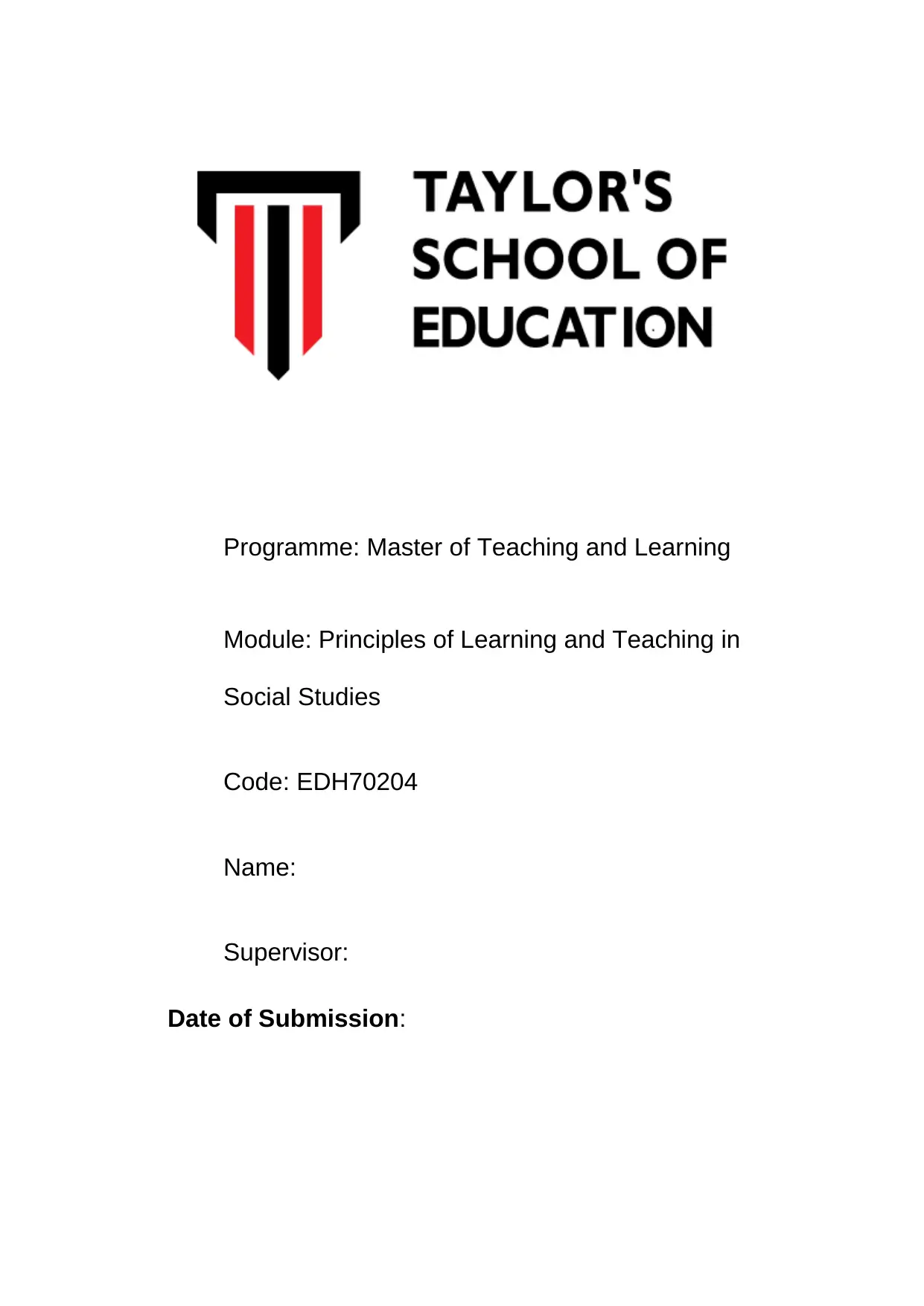
Programme: Master of Teaching and Learning
Module: Principles of Learning and Teaching in
Social Studies
Code: EDH70204
Name:
Supervisor:
Date of Submission:
Module: Principles of Learning and Teaching in
Social Studies
Code: EDH70204
Name:
Supervisor:
Date of Submission:
Paraphrase This Document
Need a fresh take? Get an instant paraphrase of this document with our AI Paraphraser
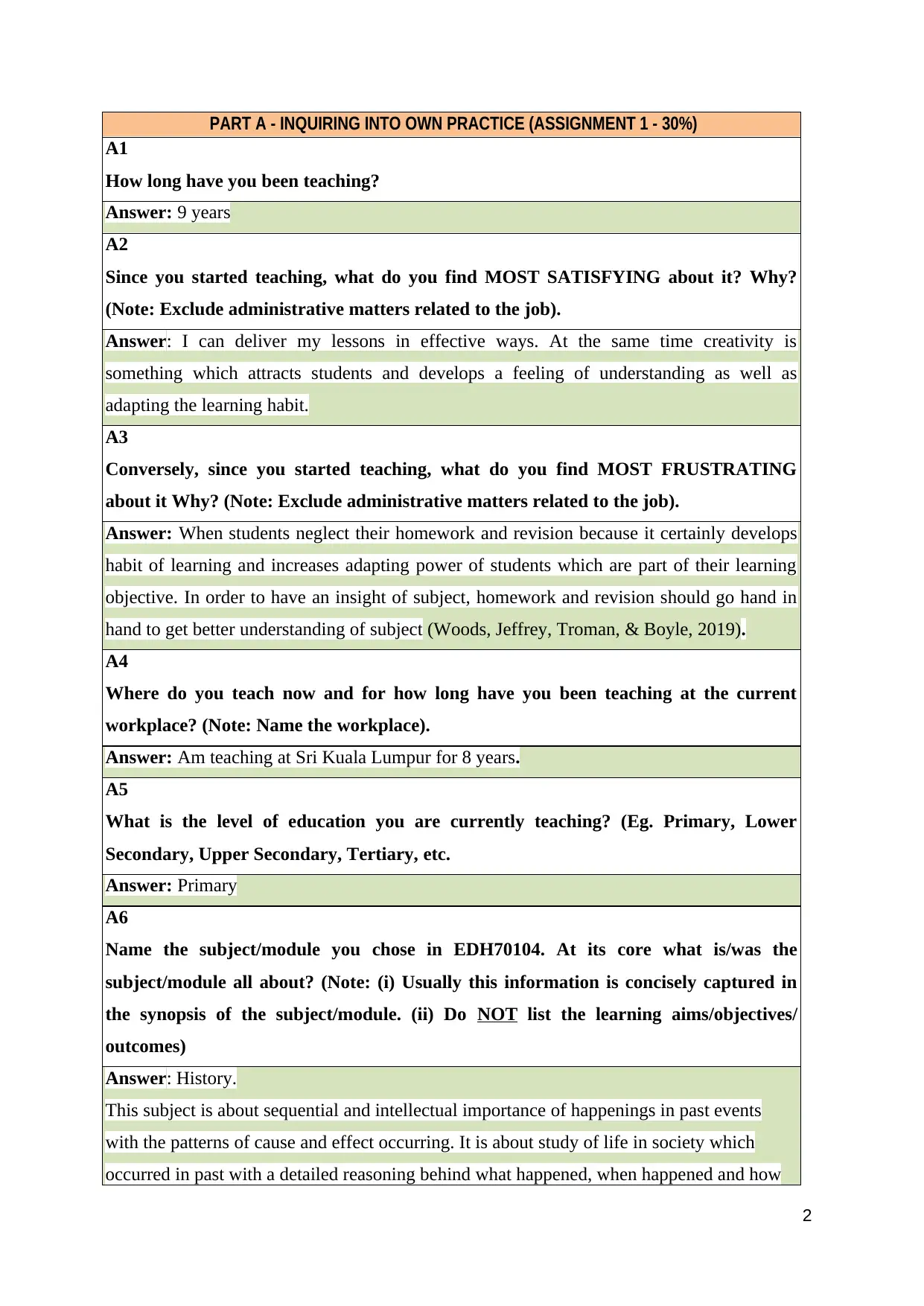
PART A - INQUIRING INTO OWN PRACTICE (ASSIGNMENT 1 - 30%)
A1
How long have you been teaching?
Answer: 9 years
A2
Since you started teaching, what do you find MOST SATISFYING about it? Why?
(Note: Exclude administrative matters related to the job).
Answer: I can deliver my lessons in effective ways. At the same time creativity is
something which attracts students and develops a feeling of understanding as well as
adapting the learning habit.
A3
Conversely, since you started teaching, what do you find MOST FRUSTRATING
about it Why? (Note: Exclude administrative matters related to the job).
Answer: When students neglect their homework and revision because it certainly develops
habit of learning and increases adapting power of students which are part of their learning
objective. In order to have an insight of subject, homework and revision should go hand in
hand to get better understanding of subject (Woods, Jeffrey, Troman, & Boyle, 2019).
A4
Where do you teach now and for how long have you been teaching at the current
workplace? (Note: Name the workplace).
Answer: Am teaching at Sri Kuala Lumpur for 8 years.
A5
What is the level of education you are currently teaching? (Eg. Primary, Lower
Secondary, Upper Secondary, Tertiary, etc.
Answer: Primary
A6
Name the subject/module you chose in EDH70104. At its core what is/was the
subject/module all about? (Note: (i) Usually this information is concisely captured in
the synopsis of the subject/module. (ii) Do NOT list the learning aims/objectives/
outcomes)
Answer: History.
This subject is about sequential and intellectual importance of happenings in past events
with the patterns of cause and effect occurring. It is about study of life in society which
occurred in past with a detailed reasoning behind what happened, when happened and how
2
A1
How long have you been teaching?
Answer: 9 years
A2
Since you started teaching, what do you find MOST SATISFYING about it? Why?
(Note: Exclude administrative matters related to the job).
Answer: I can deliver my lessons in effective ways. At the same time creativity is
something which attracts students and develops a feeling of understanding as well as
adapting the learning habit.
A3
Conversely, since you started teaching, what do you find MOST FRUSTRATING
about it Why? (Note: Exclude administrative matters related to the job).
Answer: When students neglect their homework and revision because it certainly develops
habit of learning and increases adapting power of students which are part of their learning
objective. In order to have an insight of subject, homework and revision should go hand in
hand to get better understanding of subject (Woods, Jeffrey, Troman, & Boyle, 2019).
A4
Where do you teach now and for how long have you been teaching at the current
workplace? (Note: Name the workplace).
Answer: Am teaching at Sri Kuala Lumpur for 8 years.
A5
What is the level of education you are currently teaching? (Eg. Primary, Lower
Secondary, Upper Secondary, Tertiary, etc.
Answer: Primary
A6
Name the subject/module you chose in EDH70104. At its core what is/was the
subject/module all about? (Note: (i) Usually this information is concisely captured in
the synopsis of the subject/module. (ii) Do NOT list the learning aims/objectives/
outcomes)
Answer: History.
This subject is about sequential and intellectual importance of happenings in past events
with the patterns of cause and effect occurring. It is about study of life in society which
occurred in past with a detailed reasoning behind what happened, when happened and how
2
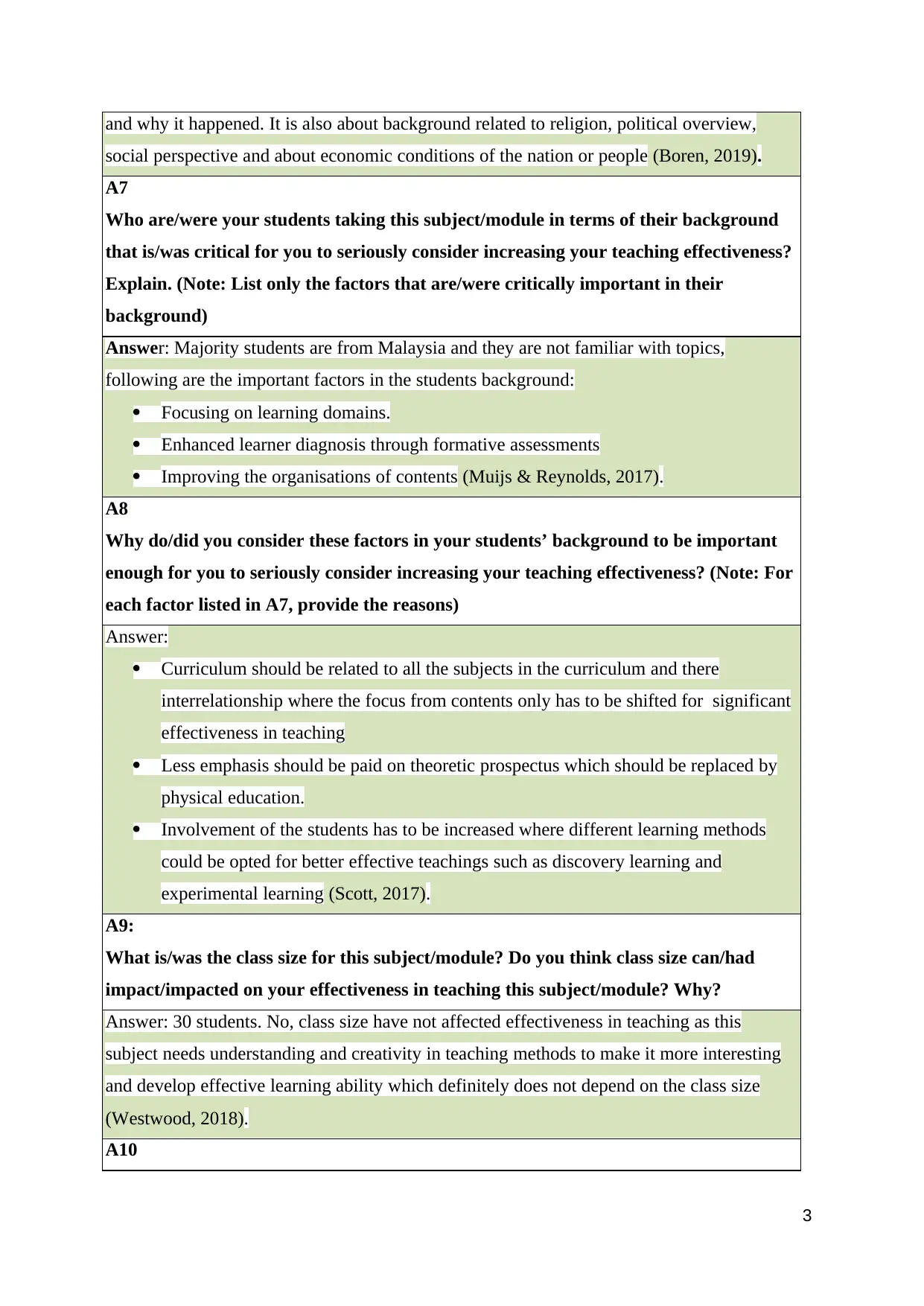
and why it happened. It is also about background related to religion, political overview,
social perspective and about economic conditions of the nation or people (Boren, 2019).
A7
Who are/were your students taking this subject/module in terms of their background
that is/was critical for you to seriously consider increasing your teaching effectiveness?
Explain. (Note: List only the factors that are/were critically important in their
background)
Answer: Majority students are from Malaysia and they are not familiar with topics,
following are the important factors in the students background:
Focusing on learning domains.
Enhanced learner diagnosis through formative assessments
Improving the organisations of contents (Muijs & Reynolds, 2017).
A8
Why do/did you consider these factors in your students’ background to be important
enough for you to seriously consider increasing your teaching effectiveness? (Note: For
each factor listed in A7, provide the reasons)
Answer:
Curriculum should be related to all the subjects in the curriculum and there
interrelationship where the focus from contents only has to be shifted for significant
effectiveness in teaching
Less emphasis should be paid on theoretic prospectus which should be replaced by
physical education.
Involvement of the students has to be increased where different learning methods
could be opted for better effective teachings such as discovery learning and
experimental learning (Scott, 2017).
A9:
What is/was the class size for this subject/module? Do you think class size can/had
impact/impacted on your effectiveness in teaching this subject/module? Why?
Answer: 30 students. No, class size have not affected effectiveness in teaching as this
subject needs understanding and creativity in teaching methods to make it more interesting
and develop effective learning ability which definitely does not depend on the class size
(Westwood, 2018).
A10
3
social perspective and about economic conditions of the nation or people (Boren, 2019).
A7
Who are/were your students taking this subject/module in terms of their background
that is/was critical for you to seriously consider increasing your teaching effectiveness?
Explain. (Note: List only the factors that are/were critically important in their
background)
Answer: Majority students are from Malaysia and they are not familiar with topics,
following are the important factors in the students background:
Focusing on learning domains.
Enhanced learner diagnosis through formative assessments
Improving the organisations of contents (Muijs & Reynolds, 2017).
A8
Why do/did you consider these factors in your students’ background to be important
enough for you to seriously consider increasing your teaching effectiveness? (Note: For
each factor listed in A7, provide the reasons)
Answer:
Curriculum should be related to all the subjects in the curriculum and there
interrelationship where the focus from contents only has to be shifted for significant
effectiveness in teaching
Less emphasis should be paid on theoretic prospectus which should be replaced by
physical education.
Involvement of the students has to be increased where different learning methods
could be opted for better effective teachings such as discovery learning and
experimental learning (Scott, 2017).
A9:
What is/was the class size for this subject/module? Do you think class size can/had
impact/impacted on your effectiveness in teaching this subject/module? Why?
Answer: 30 students. No, class size have not affected effectiveness in teaching as this
subject needs understanding and creativity in teaching methods to make it more interesting
and develop effective learning ability which definitely does not depend on the class size
(Westwood, 2018).
A10
3
⊘ This is a preview!⊘
Do you want full access?
Subscribe today to unlock all pages.

Trusted by 1+ million students worldwide
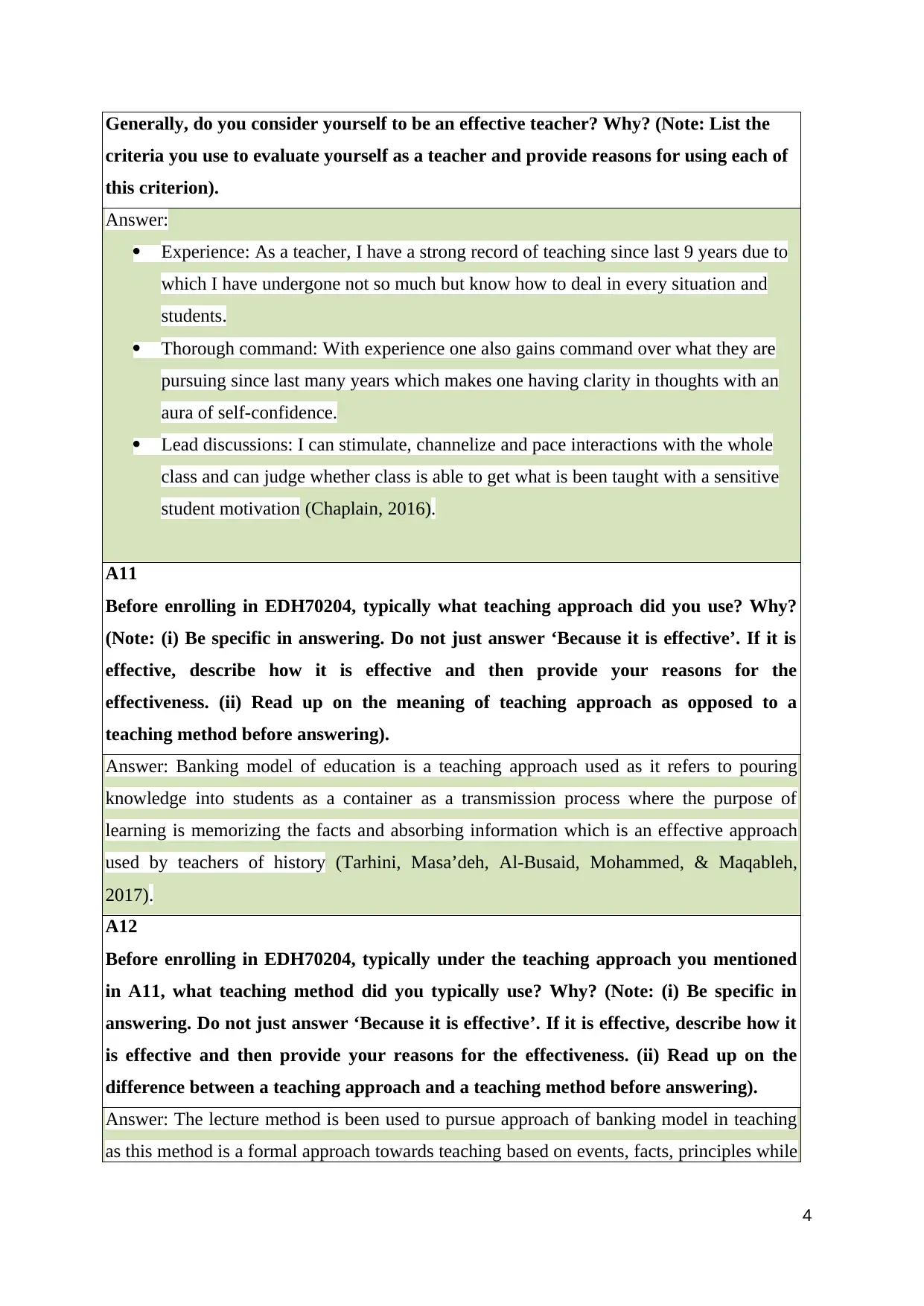
Generally, do you consider yourself to be an effective teacher? Why? (Note: List the
criteria you use to evaluate yourself as a teacher and provide reasons for using each of
this criterion).
Answer:
Experience: As a teacher, I have a strong record of teaching since last 9 years due to
which I have undergone not so much but know how to deal in every situation and
students.
Thorough command: With experience one also gains command over what they are
pursuing since last many years which makes one having clarity in thoughts with an
aura of self-confidence.
Lead discussions: I can stimulate, channelize and pace interactions with the whole
class and can judge whether class is able to get what is been taught with a sensitive
student motivation (Chaplain, 2016).
A11
Before enrolling in EDH70204, typically what teaching approach did you use? Why?
(Note: (i) Be specific in answering. Do not just answer ‘Because it is effective’. If it is
effective, describe how it is effective and then provide your reasons for the
effectiveness. (ii) Read up on the meaning of teaching approach as opposed to a
teaching method before answering).
Answer: Banking model of education is a teaching approach used as it refers to pouring
knowledge into students as a container as a transmission process where the purpose of
learning is memorizing the facts and absorbing information which is an effective approach
used by teachers of history (Tarhini, Masa’deh, Al-Busaid, Mohammed, & Maqableh,
2017).
A12
Before enrolling in EDH70204, typically under the teaching approach you mentioned
in A11, what teaching method did you typically use? Why? (Note: (i) Be specific in
answering. Do not just answer ‘Because it is effective’. If it is effective, describe how it
is effective and then provide your reasons for the effectiveness. (ii) Read up on the
difference between a teaching approach and a teaching method before answering).
Answer: The lecture method is been used to pursue approach of banking model in teaching
as this method is a formal approach towards teaching based on events, facts, principles while
4
criteria you use to evaluate yourself as a teacher and provide reasons for using each of
this criterion).
Answer:
Experience: As a teacher, I have a strong record of teaching since last 9 years due to
which I have undergone not so much but know how to deal in every situation and
students.
Thorough command: With experience one also gains command over what they are
pursuing since last many years which makes one having clarity in thoughts with an
aura of self-confidence.
Lead discussions: I can stimulate, channelize and pace interactions with the whole
class and can judge whether class is able to get what is been taught with a sensitive
student motivation (Chaplain, 2016).
A11
Before enrolling in EDH70204, typically what teaching approach did you use? Why?
(Note: (i) Be specific in answering. Do not just answer ‘Because it is effective’. If it is
effective, describe how it is effective and then provide your reasons for the
effectiveness. (ii) Read up on the meaning of teaching approach as opposed to a
teaching method before answering).
Answer: Banking model of education is a teaching approach used as it refers to pouring
knowledge into students as a container as a transmission process where the purpose of
learning is memorizing the facts and absorbing information which is an effective approach
used by teachers of history (Tarhini, Masa’deh, Al-Busaid, Mohammed, & Maqableh,
2017).
A12
Before enrolling in EDH70204, typically under the teaching approach you mentioned
in A11, what teaching method did you typically use? Why? (Note: (i) Be specific in
answering. Do not just answer ‘Because it is effective’. If it is effective, describe how it
is effective and then provide your reasons for the effectiveness. (ii) Read up on the
difference between a teaching approach and a teaching method before answering).
Answer: The lecture method is been used to pursue approach of banking model in teaching
as this method is a formal approach towards teaching based on events, facts, principles while
4
Paraphrase This Document
Need a fresh take? Get an instant paraphrase of this document with our AI Paraphraser
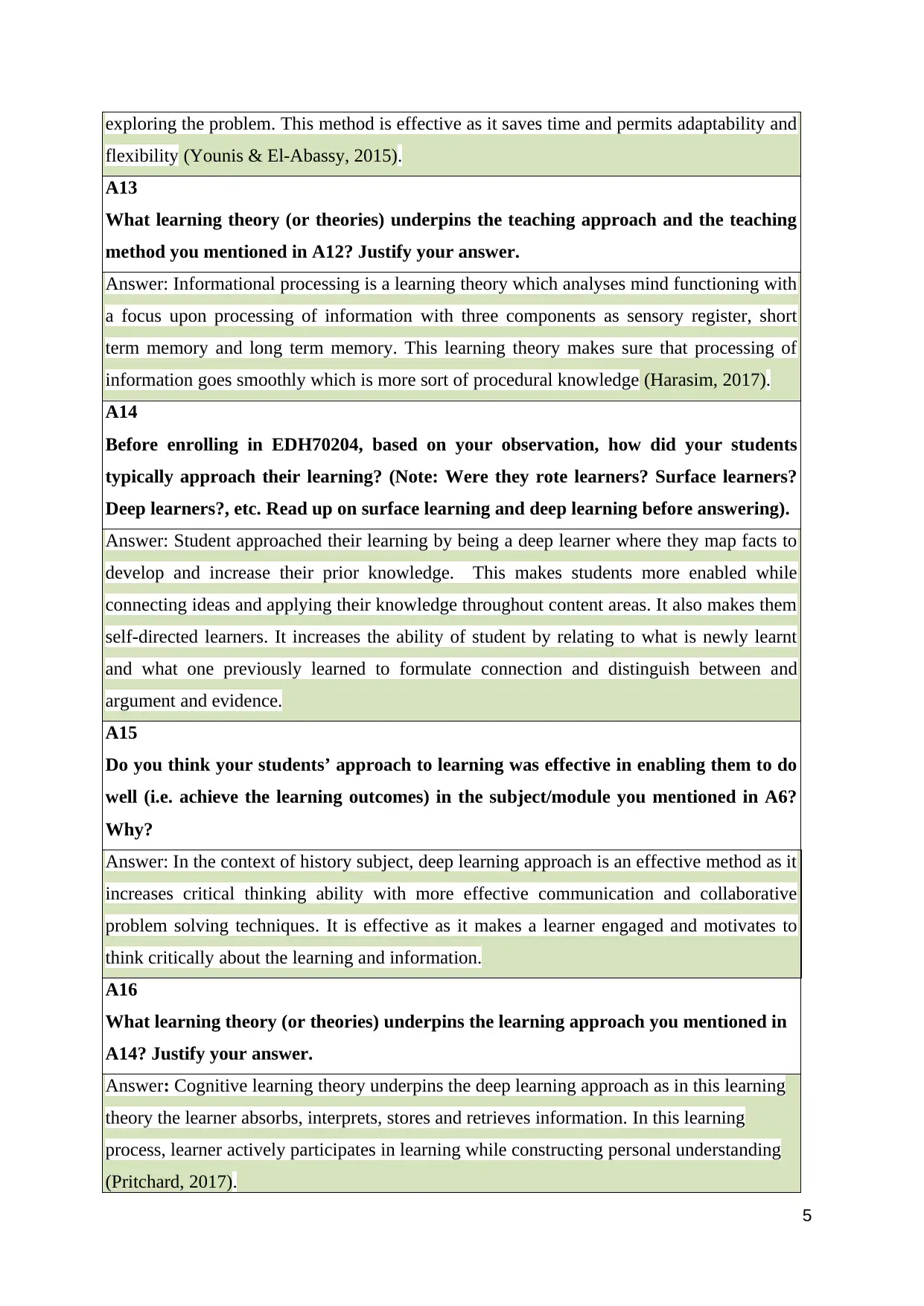
exploring the problem. This method is effective as it saves time and permits adaptability and
flexibility (Younis & El-Abassy, 2015).
A13
What learning theory (or theories) underpins the teaching approach and the teaching
method you mentioned in A12? Justify your answer.
Answer: Informational processing is a learning theory which analyses mind functioning with
a focus upon processing of information with three components as sensory register, short
term memory and long term memory. This learning theory makes sure that processing of
information goes smoothly which is more sort of procedural knowledge (Harasim, 2017).
A14
Before enrolling in EDH70204, based on your observation, how did your students
typically approach their learning? (Note: Were they rote learners? Surface learners?
Deep learners?, etc. Read up on surface learning and deep learning before answering).
Answer: Student approached their learning by being a deep learner where they map facts to
develop and increase their prior knowledge. This makes students more enabled while
connecting ideas and applying their knowledge throughout content areas. It also makes them
self-directed learners. It increases the ability of student by relating to what is newly learnt
and what one previously learned to formulate connection and distinguish between and
argument and evidence.
A15
Do you think your students’ approach to learning was effective in enabling them to do
well (i.e. achieve the learning outcomes) in the subject/module you mentioned in A6?
Why?
Answer: In the context of history subject, deep learning approach is an effective method as it
increases critical thinking ability with more effective communication and collaborative
problem solving techniques. It is effective as it makes a learner engaged and motivates to
think critically about the learning and information.
A16
What learning theory (or theories) underpins the learning approach you mentioned in
A14? Justify your answer.
Answer: Cognitive learning theory underpins the deep learning approach as in this learning
theory the learner absorbs, interprets, stores and retrieves information. In this learning
process, learner actively participates in learning while constructing personal understanding
(Pritchard, 2017).
5
flexibility (Younis & El-Abassy, 2015).
A13
What learning theory (or theories) underpins the teaching approach and the teaching
method you mentioned in A12? Justify your answer.
Answer: Informational processing is a learning theory which analyses mind functioning with
a focus upon processing of information with three components as sensory register, short
term memory and long term memory. This learning theory makes sure that processing of
information goes smoothly which is more sort of procedural knowledge (Harasim, 2017).
A14
Before enrolling in EDH70204, based on your observation, how did your students
typically approach their learning? (Note: Were they rote learners? Surface learners?
Deep learners?, etc. Read up on surface learning and deep learning before answering).
Answer: Student approached their learning by being a deep learner where they map facts to
develop and increase their prior knowledge. This makes students more enabled while
connecting ideas and applying their knowledge throughout content areas. It also makes them
self-directed learners. It increases the ability of student by relating to what is newly learnt
and what one previously learned to formulate connection and distinguish between and
argument and evidence.
A15
Do you think your students’ approach to learning was effective in enabling them to do
well (i.e. achieve the learning outcomes) in the subject/module you mentioned in A6?
Why?
Answer: In the context of history subject, deep learning approach is an effective method as it
increases critical thinking ability with more effective communication and collaborative
problem solving techniques. It is effective as it makes a learner engaged and motivates to
think critically about the learning and information.
A16
What learning theory (or theories) underpins the learning approach you mentioned in
A14? Justify your answer.
Answer: Cognitive learning theory underpins the deep learning approach as in this learning
theory the learner absorbs, interprets, stores and retrieves information. In this learning
process, learner actively participates in learning while constructing personal understanding
(Pritchard, 2017).
5
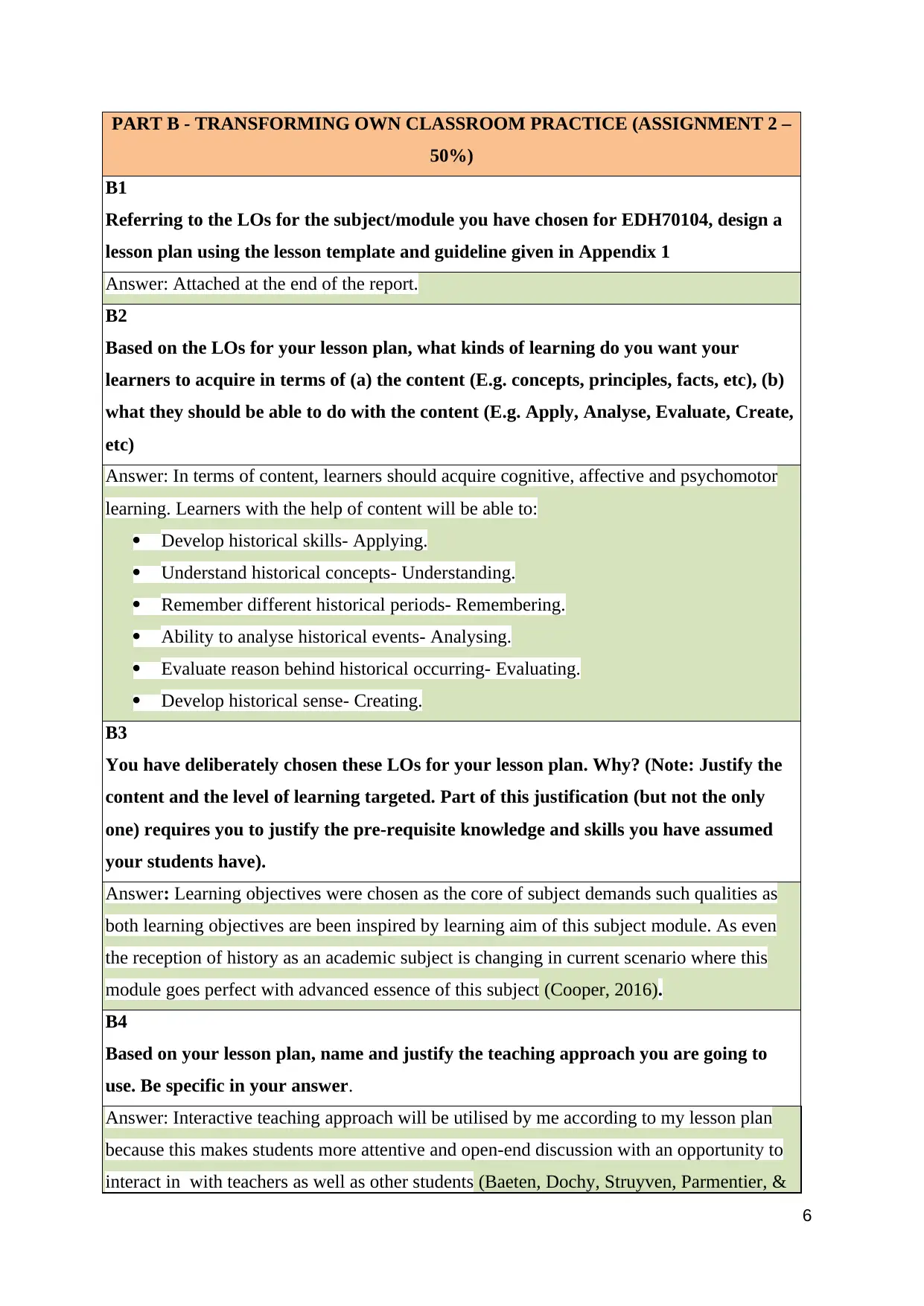
PART B - TRANSFORMING OWN CLASSROOM PRACTICE (ASSIGNMENT 2 –
50%)
B1
Referring to the LOs for the subject/module you have chosen for EDH70104, design a
lesson plan using the lesson template and guideline given in Appendix 1
Answer: Attached at the end of the report.
B2
Based on the LOs for your lesson plan, what kinds of learning do you want your
learners to acquire in terms of (a) the content (E.g. concepts, principles, facts, etc), (b)
what they should be able to do with the content (E.g. Apply, Analyse, Evaluate, Create,
etc)
Answer: In terms of content, learners should acquire cognitive, affective and psychomotor
learning. Learners with the help of content will be able to:
Develop historical skills- Applying.
Understand historical concepts- Understanding.
Remember different historical periods- Remembering.
Ability to analyse historical events- Analysing.
Evaluate reason behind historical occurring- Evaluating.
Develop historical sense- Creating.
B3
You have deliberately chosen these LOs for your lesson plan. Why? (Note: Justify the
content and the level of learning targeted. Part of this justification (but not the only
one) requires you to justify the pre-requisite knowledge and skills you have assumed
your students have).
Answer: Learning objectives were chosen as the core of subject demands such qualities as
both learning objectives are been inspired by learning aim of this subject module. As even
the reception of history as an academic subject is changing in current scenario where this
module goes perfect with advanced essence of this subject (Cooper, 2016).
B4
Based on your lesson plan, name and justify the teaching approach you are going to
use. Be specific in your answer.
Answer: Interactive teaching approach will be utilised by me according to my lesson plan
because this makes students more attentive and open-end discussion with an opportunity to
interact in with teachers as well as other students (Baeten, Dochy, Struyven, Parmentier, &
6
50%)
B1
Referring to the LOs for the subject/module you have chosen for EDH70104, design a
lesson plan using the lesson template and guideline given in Appendix 1
Answer: Attached at the end of the report.
B2
Based on the LOs for your lesson plan, what kinds of learning do you want your
learners to acquire in terms of (a) the content (E.g. concepts, principles, facts, etc), (b)
what they should be able to do with the content (E.g. Apply, Analyse, Evaluate, Create,
etc)
Answer: In terms of content, learners should acquire cognitive, affective and psychomotor
learning. Learners with the help of content will be able to:
Develop historical skills- Applying.
Understand historical concepts- Understanding.
Remember different historical periods- Remembering.
Ability to analyse historical events- Analysing.
Evaluate reason behind historical occurring- Evaluating.
Develop historical sense- Creating.
B3
You have deliberately chosen these LOs for your lesson plan. Why? (Note: Justify the
content and the level of learning targeted. Part of this justification (but not the only
one) requires you to justify the pre-requisite knowledge and skills you have assumed
your students have).
Answer: Learning objectives were chosen as the core of subject demands such qualities as
both learning objectives are been inspired by learning aim of this subject module. As even
the reception of history as an academic subject is changing in current scenario where this
module goes perfect with advanced essence of this subject (Cooper, 2016).
B4
Based on your lesson plan, name and justify the teaching approach you are going to
use. Be specific in your answer.
Answer: Interactive teaching approach will be utilised by me according to my lesson plan
because this makes students more attentive and open-end discussion with an opportunity to
interact in with teachers as well as other students (Baeten, Dochy, Struyven, Parmentier, &
6
⊘ This is a preview!⊘
Do you want full access?
Subscribe today to unlock all pages.

Trusted by 1+ million students worldwide
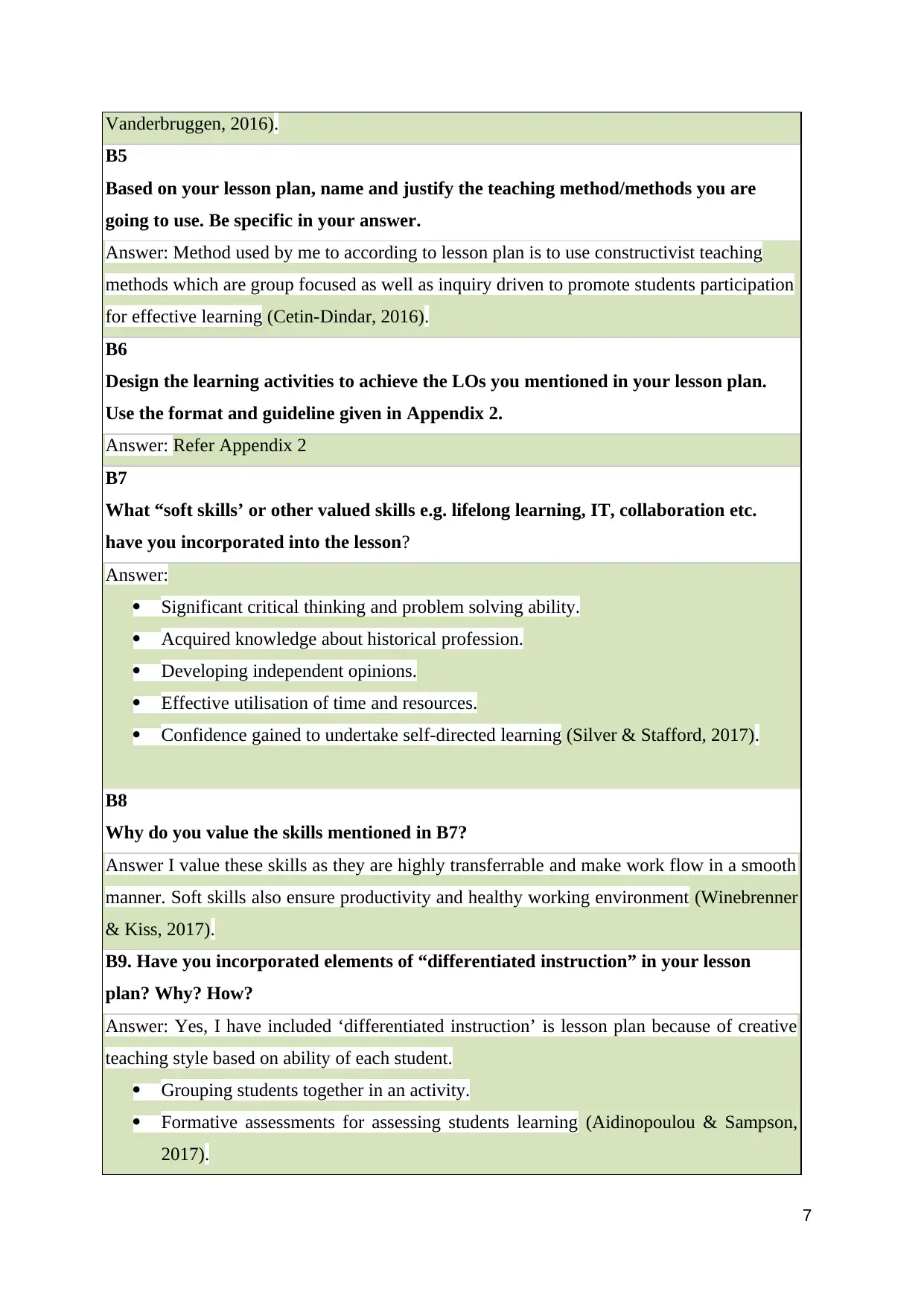
Vanderbruggen, 2016).
B5
Based on your lesson plan, name and justify the teaching method/methods you are
going to use. Be specific in your answer.
Answer: Method used by me to according to lesson plan is to use constructivist teaching
methods which are group focused as well as inquiry driven to promote students participation
for effective learning (Cetin-Dindar, 2016).
B6
Design the learning activities to achieve the LOs you mentioned in your lesson plan.
Use the format and guideline given in Appendix 2.
Answer: Refer Appendix 2
B7
What “soft skills’ or other valued skills e.g. lifelong learning, IT, collaboration etc.
have you incorporated into the lesson?
Answer:
Significant critical thinking and problem solving ability.
Acquired knowledge about historical profession.
Developing independent opinions.
Effective utilisation of time and resources.
Confidence gained to undertake self-directed learning (Silver & Stafford, 2017).
B8
Why do you value the skills mentioned in B7?
Answer I value these skills as they are highly transferrable and make work flow in a smooth
manner. Soft skills also ensure productivity and healthy working environment (Winebrenner
& Kiss, 2017).
B9. Have you incorporated elements of “differentiated instruction” in your lesson
plan? Why? How?
Answer: Yes, I have included ‘differentiated instruction’ is lesson plan because of creative
teaching style based on ability of each student.
Grouping students together in an activity.
Formative assessments for assessing students learning (Aidinopoulou & Sampson,
2017).
7
B5
Based on your lesson plan, name and justify the teaching method/methods you are
going to use. Be specific in your answer.
Answer: Method used by me to according to lesson plan is to use constructivist teaching
methods which are group focused as well as inquiry driven to promote students participation
for effective learning (Cetin-Dindar, 2016).
B6
Design the learning activities to achieve the LOs you mentioned in your lesson plan.
Use the format and guideline given in Appendix 2.
Answer: Refer Appendix 2
B7
What “soft skills’ or other valued skills e.g. lifelong learning, IT, collaboration etc.
have you incorporated into the lesson?
Answer:
Significant critical thinking and problem solving ability.
Acquired knowledge about historical profession.
Developing independent opinions.
Effective utilisation of time and resources.
Confidence gained to undertake self-directed learning (Silver & Stafford, 2017).
B8
Why do you value the skills mentioned in B7?
Answer I value these skills as they are highly transferrable and make work flow in a smooth
manner. Soft skills also ensure productivity and healthy working environment (Winebrenner
& Kiss, 2017).
B9. Have you incorporated elements of “differentiated instruction” in your lesson
plan? Why? How?
Answer: Yes, I have included ‘differentiated instruction’ is lesson plan because of creative
teaching style based on ability of each student.
Grouping students together in an activity.
Formative assessments for assessing students learning (Aidinopoulou & Sampson,
2017).
7
Paraphrase This Document
Need a fresh take? Get an instant paraphrase of this document with our AI Paraphraser
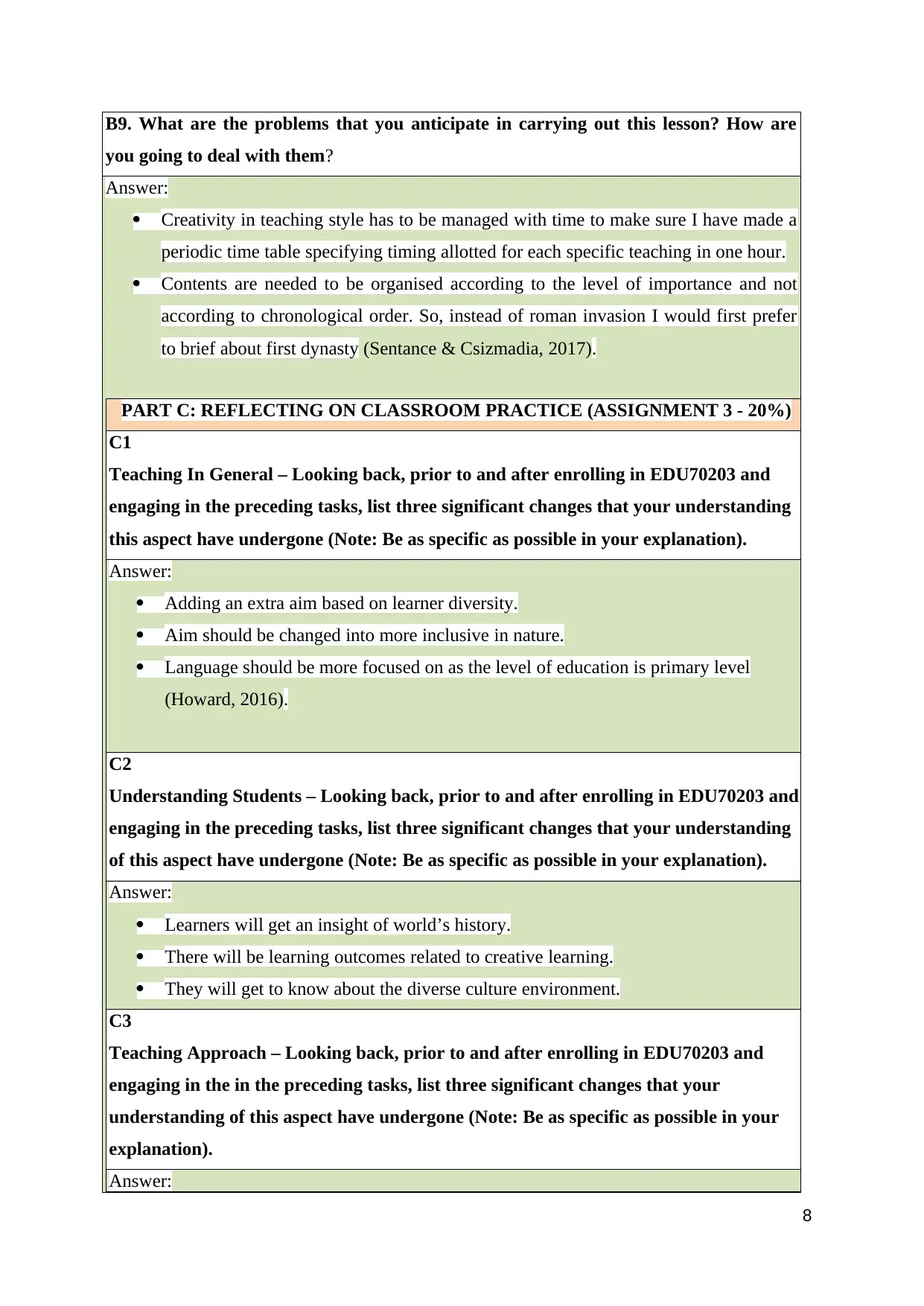
B9. What are the problems that you anticipate in carrying out this lesson? How are
you going to deal with them?
Answer:
Creativity in teaching style has to be managed with time to make sure I have made a
periodic time table specifying timing allotted for each specific teaching in one hour.
Contents are needed to be organised according to the level of importance and not
according to chronological order. So, instead of roman invasion I would first prefer
to brief about first dynasty (Sentance & Csizmadia, 2017).
PART C: REFLECTING ON CLASSROOM PRACTICE (ASSIGNMENT 3 - 20%)
C1
Teaching In General – Looking back, prior to and after enrolling in EDU70203 and
engaging in the preceding tasks, list three significant changes that your understanding
this aspect have undergone (Note: Be as specific as possible in your explanation).
Answer:
Adding an extra aim based on learner diversity.
Aim should be changed into more inclusive in nature.
Language should be more focused on as the level of education is primary level
(Howard, 2016).
C2
Understanding Students – Looking back, prior to and after enrolling in EDU70203 and
engaging in the preceding tasks, list three significant changes that your understanding
of this aspect have undergone (Note: Be as specific as possible in your explanation).
Answer:
Learners will get an insight of world’s history.
There will be learning outcomes related to creative learning.
They will get to know about the diverse culture environment.
C3
Teaching Approach – Looking back, prior to and after enrolling in EDU70203 and
engaging in the in the preceding tasks, list three significant changes that your
understanding of this aspect have undergone (Note: Be as specific as possible in your
explanation).
Answer:
8
you going to deal with them?
Answer:
Creativity in teaching style has to be managed with time to make sure I have made a
periodic time table specifying timing allotted for each specific teaching in one hour.
Contents are needed to be organised according to the level of importance and not
according to chronological order. So, instead of roman invasion I would first prefer
to brief about first dynasty (Sentance & Csizmadia, 2017).
PART C: REFLECTING ON CLASSROOM PRACTICE (ASSIGNMENT 3 - 20%)
C1
Teaching In General – Looking back, prior to and after enrolling in EDU70203 and
engaging in the preceding tasks, list three significant changes that your understanding
this aspect have undergone (Note: Be as specific as possible in your explanation).
Answer:
Adding an extra aim based on learner diversity.
Aim should be changed into more inclusive in nature.
Language should be more focused on as the level of education is primary level
(Howard, 2016).
C2
Understanding Students – Looking back, prior to and after enrolling in EDU70203 and
engaging in the preceding tasks, list three significant changes that your understanding
of this aspect have undergone (Note: Be as specific as possible in your explanation).
Answer:
Learners will get an insight of world’s history.
There will be learning outcomes related to creative learning.
They will get to know about the diverse culture environment.
C3
Teaching Approach – Looking back, prior to and after enrolling in EDU70203 and
engaging in the in the preceding tasks, list three significant changes that your
understanding of this aspect have undergone (Note: Be as specific as possible in your
explanation).
Answer:
8
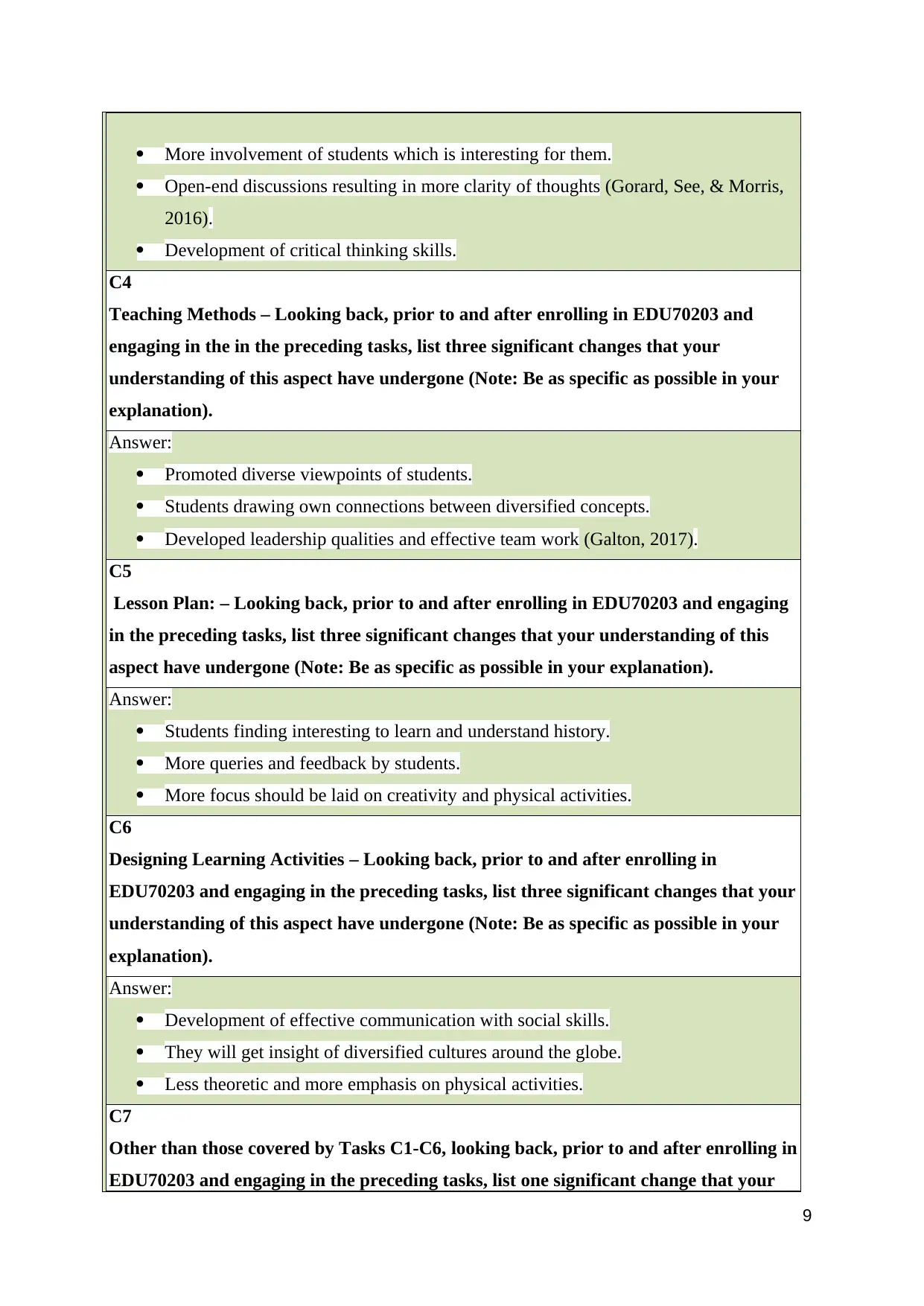
More involvement of students which is interesting for them.
Open-end discussions resulting in more clarity of thoughts (Gorard, See, & Morris,
2016).
Development of critical thinking skills.
C4
Teaching Methods – Looking back, prior to and after enrolling in EDU70203 and
engaging in the in the preceding tasks, list three significant changes that your
understanding of this aspect have undergone (Note: Be as specific as possible in your
explanation).
Answer:
Promoted diverse viewpoints of students.
Students drawing own connections between diversified concepts.
Developed leadership qualities and effective team work (Galton, 2017).
C5
Lesson Plan: – Looking back, prior to and after enrolling in EDU70203 and engaging
in the preceding tasks, list three significant changes that your understanding of this
aspect have undergone (Note: Be as specific as possible in your explanation).
Answer:
Students finding interesting to learn and understand history.
More queries and feedback by students.
More focus should be laid on creativity and physical activities.
C6
Designing Learning Activities – Looking back, prior to and after enrolling in
EDU70203 and engaging in the preceding tasks, list three significant changes that your
understanding of this aspect have undergone (Note: Be as specific as possible in your
explanation).
Answer:
Development of effective communication with social skills.
They will get insight of diversified cultures around the globe.
Less theoretic and more emphasis on physical activities.
C7
Other than those covered by Tasks C1-C6, looking back, prior to and after enrolling in
EDU70203 and engaging in the preceding tasks, list one significant change that your
9
Open-end discussions resulting in more clarity of thoughts (Gorard, See, & Morris,
2016).
Development of critical thinking skills.
C4
Teaching Methods – Looking back, prior to and after enrolling in EDU70203 and
engaging in the in the preceding tasks, list three significant changes that your
understanding of this aspect have undergone (Note: Be as specific as possible in your
explanation).
Answer:
Promoted diverse viewpoints of students.
Students drawing own connections between diversified concepts.
Developed leadership qualities and effective team work (Galton, 2017).
C5
Lesson Plan: – Looking back, prior to and after enrolling in EDU70203 and engaging
in the preceding tasks, list three significant changes that your understanding of this
aspect have undergone (Note: Be as specific as possible in your explanation).
Answer:
Students finding interesting to learn and understand history.
More queries and feedback by students.
More focus should be laid on creativity and physical activities.
C6
Designing Learning Activities – Looking back, prior to and after enrolling in
EDU70203 and engaging in the preceding tasks, list three significant changes that your
understanding of this aspect have undergone (Note: Be as specific as possible in your
explanation).
Answer:
Development of effective communication with social skills.
They will get insight of diversified cultures around the globe.
Less theoretic and more emphasis on physical activities.
C7
Other than those covered by Tasks C1-C6, looking back, prior to and after enrolling in
EDU70203 and engaging in the preceding tasks, list one significant change that your
9
⊘ This is a preview!⊘
Do you want full access?
Subscribe today to unlock all pages.

Trusted by 1+ million students worldwide
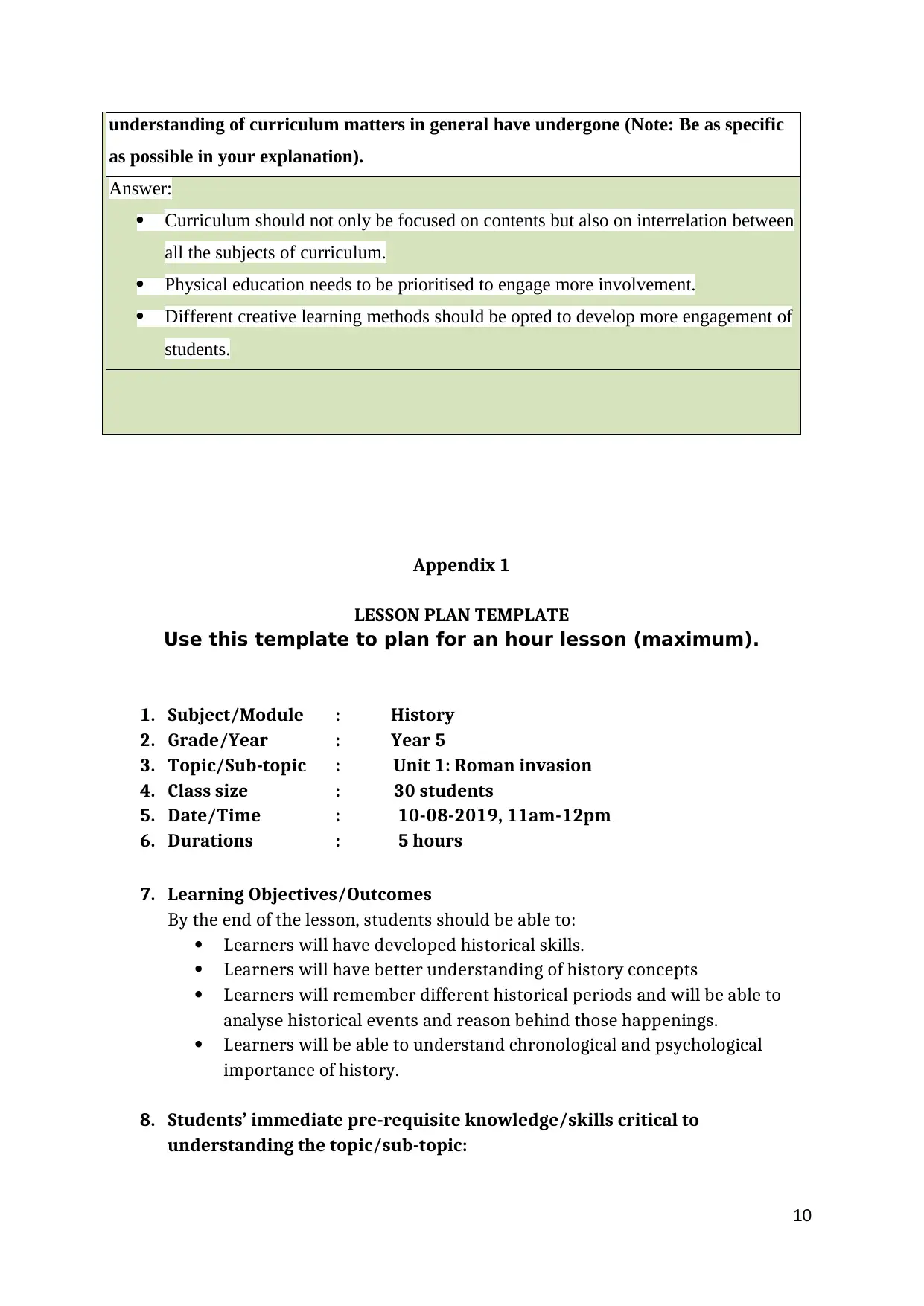
understanding of curriculum matters in general have undergone (Note: Be as specific
as possible in your explanation).
Answer:
Curriculum should not only be focused on contents but also on interrelation between
all the subjects of curriculum.
Physical education needs to be prioritised to engage more involvement.
Different creative learning methods should be opted to develop more engagement of
students.
Appendix 1
LESSON PLAN TEMPLATE
Use this template to plan for an hour lesson (maximum).
1. Subject/Module : History
2. Grade/Year : Year 5
3. Topic/Sub-topic : Unit 1: Roman invasion
4. Class size : 30 students
5. Date/Time : 10-08-2019, 11am-12pm
6. Durations : 5 hours
7. Learning Objectives/Outcomes
By the end of the lesson, students should be able to:
Learners will have developed historical skills.
Learners will have better understanding of history concepts
Learners will remember different historical periods and will be able to
analyse historical events and reason behind those happenings.
Learners will be able to understand chronological and psychological
importance of history.
8. Students’ immediate pre-requisite knowledge/skills critical to
understanding the topic/sub-topic:
10
as possible in your explanation).
Answer:
Curriculum should not only be focused on contents but also on interrelation between
all the subjects of curriculum.
Physical education needs to be prioritised to engage more involvement.
Different creative learning methods should be opted to develop more engagement of
students.
Appendix 1
LESSON PLAN TEMPLATE
Use this template to plan for an hour lesson (maximum).
1. Subject/Module : History
2. Grade/Year : Year 5
3. Topic/Sub-topic : Unit 1: Roman invasion
4. Class size : 30 students
5. Date/Time : 10-08-2019, 11am-12pm
6. Durations : 5 hours
7. Learning Objectives/Outcomes
By the end of the lesson, students should be able to:
Learners will have developed historical skills.
Learners will have better understanding of history concepts
Learners will remember different historical periods and will be able to
analyse historical events and reason behind those happenings.
Learners will be able to understand chronological and psychological
importance of history.
8. Students’ immediate pre-requisite knowledge/skills critical to
understanding the topic/sub-topic:
10
Paraphrase This Document
Need a fresh take? Get an instant paraphrase of this document with our AI Paraphraser
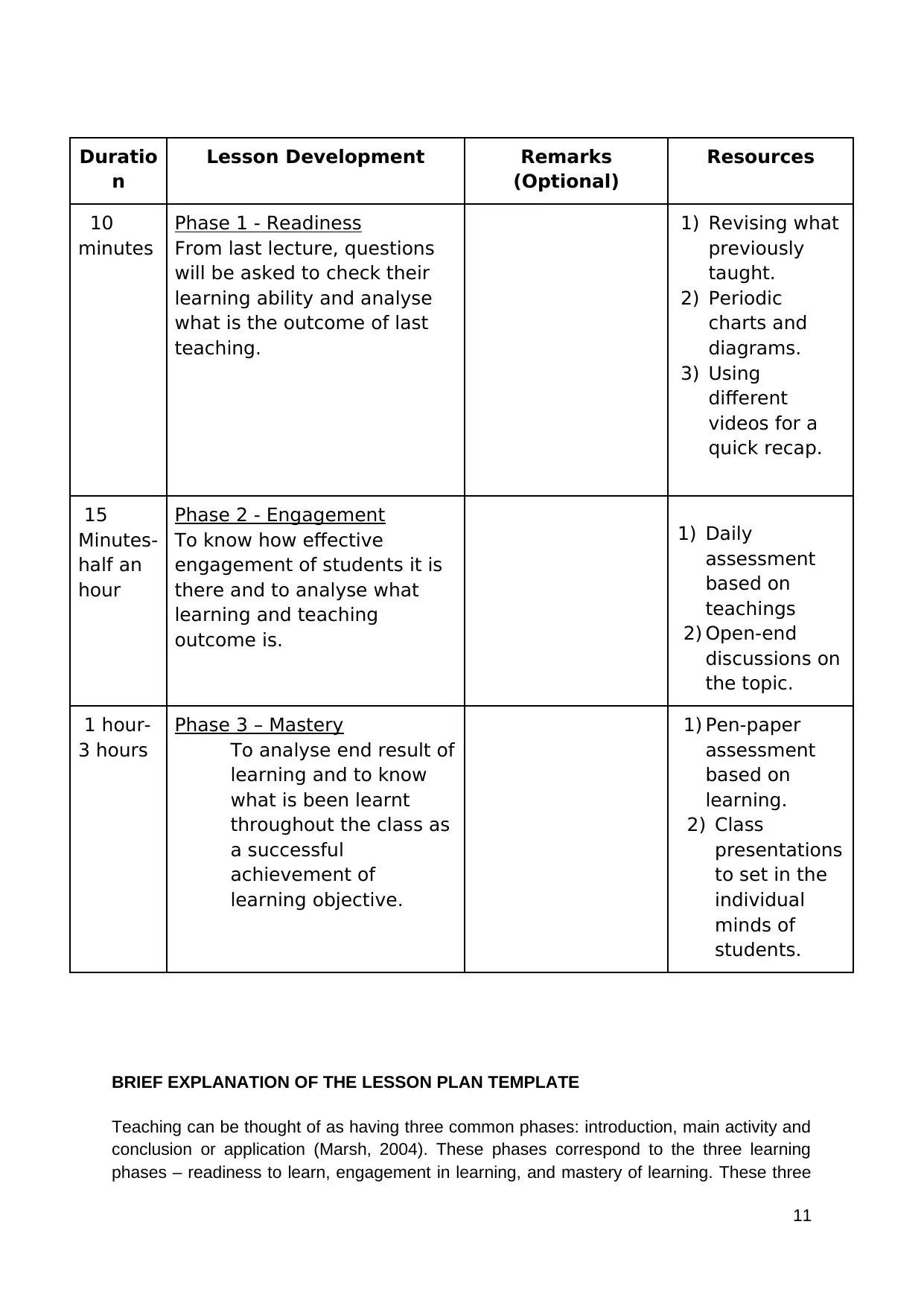
Duratio
n
Lesson Development Remarks
(Optional)
Resources
10
minutes
Phase 1 - Readiness
From last lecture, questions
will be asked to check their
learning ability and analyse
what is the outcome of last
teaching.
1) Revising what
previously
taught.
2) Periodic
charts and
diagrams.
3) Using
different
videos for a
quick recap.
15
Minutes-
half an
hour
Phase 2 - Engagement
To know how effective
engagement of students it is
there and to analyse what
learning and teaching
outcome is.
1) Daily
assessment
based on
teachings
2) Open-end
discussions on
the topic.
1 hour-
3 hours
Phase 3 – Mastery
To analyse end result of
learning and to know
what is been learnt
throughout the class as
a successful
achievement of
learning objective.
1) Pen-paper
assessment
based on
learning.
2) Class
presentations
to set in the
individual
minds of
students.
BRIEF EXPLANATION OF THE LESSON PLAN TEMPLATE
Teaching can be thought of as having three common phases: introduction, main activity and
conclusion or application (Marsh, 2004). These phases correspond to the three learning
phases – readiness to learn, engagement in learning, and mastery of learning. These three
11
n
Lesson Development Remarks
(Optional)
Resources
10
minutes
Phase 1 - Readiness
From last lecture, questions
will be asked to check their
learning ability and analyse
what is the outcome of last
teaching.
1) Revising what
previously
taught.
2) Periodic
charts and
diagrams.
3) Using
different
videos for a
quick recap.
15
Minutes-
half an
hour
Phase 2 - Engagement
To know how effective
engagement of students it is
there and to analyse what
learning and teaching
outcome is.
1) Daily
assessment
based on
teachings
2) Open-end
discussions on
the topic.
1 hour-
3 hours
Phase 3 – Mastery
To analyse end result of
learning and to know
what is been learnt
throughout the class as
a successful
achievement of
learning objective.
1) Pen-paper
assessment
based on
learning.
2) Class
presentations
to set in the
individual
minds of
students.
BRIEF EXPLANATION OF THE LESSON PLAN TEMPLATE
Teaching can be thought of as having three common phases: introduction, main activity and
conclusion or application (Marsh, 2004). These phases correspond to the three learning
phases – readiness to learn, engagement in learning, and mastery of learning. These three
11
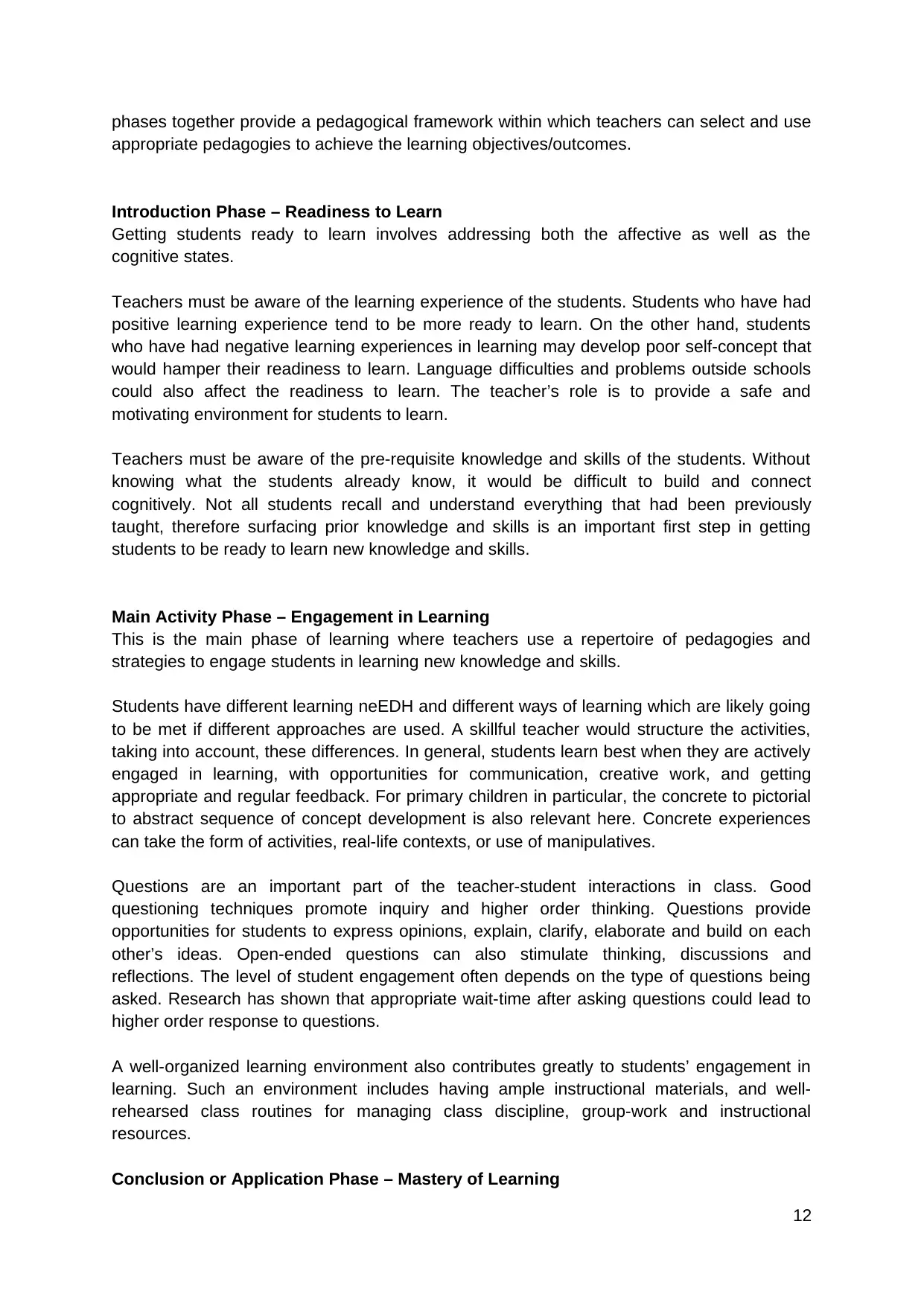
phases together provide a pedagogical framework within which teachers can select and use
appropriate pedagogies to achieve the learning objectives/outcomes.
Introduction Phase – Readiness to Learn
Getting students ready to learn involves addressing both the affective as well as the
cognitive states.
Teachers must be aware of the learning experience of the students. Students who have had
positive learning experience tend to be more ready to learn. On the other hand, students
who have had negative learning experiences in learning may develop poor self-concept that
would hamper their readiness to learn. Language difficulties and problems outside schools
could also affect the readiness to learn. The teacher’s role is to provide a safe and
motivating environment for students to learn.
Teachers must be aware of the pre-requisite knowledge and skills of the students. Without
knowing what the students already know, it would be difficult to build and connect
cognitively. Not all students recall and understand everything that had been previously
taught, therefore surfacing prior knowledge and skills is an important first step in getting
students to be ready to learn new knowledge and skills.
Main Activity Phase – Engagement in Learning
This is the main phase of learning where teachers use a repertoire of pedagogies and
strategies to engage students in learning new knowledge and skills.
Students have different learning neEDH and different ways of learning which are likely going
to be met if different approaches are used. A skillful teacher would structure the activities,
taking into account, these differences. In general, students learn best when they are actively
engaged in learning, with opportunities for communication, creative work, and getting
appropriate and regular feedback. For primary children in particular, the concrete to pictorial
to abstract sequence of concept development is also relevant here. Concrete experiences
can take the form of activities, real-life contexts, or use of manipulatives.
Questions are an important part of the teacher-student interactions in class. Good
questioning techniques promote inquiry and higher order thinking. Questions provide
opportunities for students to express opinions, explain, clarify, elaborate and build on each
other’s ideas. Open-ended questions can also stimulate thinking, discussions and
reflections. The level of student engagement often depends on the type of questions being
asked. Research has shown that appropriate wait-time after asking questions could lead to
higher order response to questions.
A well-organized learning environment also contributes greatly to students’ engagement in
learning. Such an environment includes having ample instructional materials, and well-
rehearsed class routines for managing class discipline, group-work and instructional
resources.
Conclusion or Application Phase – Mastery of Learning
12
appropriate pedagogies to achieve the learning objectives/outcomes.
Introduction Phase – Readiness to Learn
Getting students ready to learn involves addressing both the affective as well as the
cognitive states.
Teachers must be aware of the learning experience of the students. Students who have had
positive learning experience tend to be more ready to learn. On the other hand, students
who have had negative learning experiences in learning may develop poor self-concept that
would hamper their readiness to learn. Language difficulties and problems outside schools
could also affect the readiness to learn. The teacher’s role is to provide a safe and
motivating environment for students to learn.
Teachers must be aware of the pre-requisite knowledge and skills of the students. Without
knowing what the students already know, it would be difficult to build and connect
cognitively. Not all students recall and understand everything that had been previously
taught, therefore surfacing prior knowledge and skills is an important first step in getting
students to be ready to learn new knowledge and skills.
Main Activity Phase – Engagement in Learning
This is the main phase of learning where teachers use a repertoire of pedagogies and
strategies to engage students in learning new knowledge and skills.
Students have different learning neEDH and different ways of learning which are likely going
to be met if different approaches are used. A skillful teacher would structure the activities,
taking into account, these differences. In general, students learn best when they are actively
engaged in learning, with opportunities for communication, creative work, and getting
appropriate and regular feedback. For primary children in particular, the concrete to pictorial
to abstract sequence of concept development is also relevant here. Concrete experiences
can take the form of activities, real-life contexts, or use of manipulatives.
Questions are an important part of the teacher-student interactions in class. Good
questioning techniques promote inquiry and higher order thinking. Questions provide
opportunities for students to express opinions, explain, clarify, elaborate and build on each
other’s ideas. Open-ended questions can also stimulate thinking, discussions and
reflections. The level of student engagement often depends on the type of questions being
asked. Research has shown that appropriate wait-time after asking questions could lead to
higher order response to questions.
A well-organized learning environment also contributes greatly to students’ engagement in
learning. Such an environment includes having ample instructional materials, and well-
rehearsed class routines for managing class discipline, group-work and instructional
resources.
Conclusion or Application Phase – Mastery of Learning
12
⊘ This is a preview!⊘
Do you want full access?
Subscribe today to unlock all pages.

Trusted by 1+ million students worldwide
1 out of 14
Related Documents
Your All-in-One AI-Powered Toolkit for Academic Success.
+13062052269
info@desklib.com
Available 24*7 on WhatsApp / Email
![[object Object]](/_next/static/media/star-bottom.7253800d.svg)
Unlock your academic potential
Copyright © 2020–2025 A2Z Services. All Rights Reserved. Developed and managed by ZUCOL.





